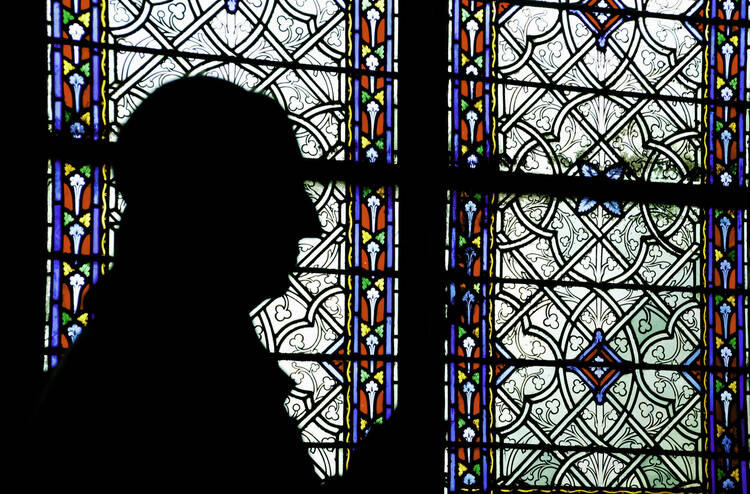On July 20, a Catholic online news commentary site, The Pillar, published a report alleging that Msgr. Jeffrey Burrill of the U. S. Conference of Catholic Bishops “engaged in serial sexual misconduct, while he held a critical oversight role in the Catholic Church’s response to the recent spate of sexual abuse and misconduct scandals.” The Pillar used “commercially available records of app signal data” to track a mobile device correlated to Monsignor Burrill that “suggest he was at the same time engaged in serial and illicit sexual activity.”
Operated by two former editors at E.W.T.N.’s Catholic News Agency, J. D. Flynn and Ed Condon, The Pillar offers news and analysis about the Catholic Church, mostly in the United States. Just before the publication of the story on July 20, the U.S.C.C.B. announced that Monsignor Burrill had resigned in light of “impending media reports alleging possible improper behavior.”
Rare is the story that manages to be so depressing in so many ways. Unpacking and analyzing Monsignor Burrill’s story, and how it came to light, is difficult because so many complicated issues are involved, each with distinct troubling threads with unclear implications. But when the story is broken down, as I have tried to do here in five points, it suggests a troubling thesis: The U.S. Catholic Church has entered a dangerous new reality.
1. A high-ranking priest may have broken his promise of celibacy.
Regardless of how it became public (though I have much to say on that below), it is important to acknowledge that it is a bad thing if the highest-ranking priest in the U.S. church is regularly breaking his promise of celibacy. Even in consensual relationships, a priest’s commitment to celibacy and chastity is important for his own sexual integrity as much as it is a witness to the rest of the church. It is sad news in the same way that news of a cheating spouse is sad. And what The Pillar’s report is alleging is not a moment of weakness but a pattern of leading a secret double life.
Monsignor Burrill, while not a household name, is not an average Catholic, or even an average cleric. As general secretary of the U.S.C.C.B., he helped run a prominent body representing the church in the United States and maintained significant influence over church policies and statements—including those dealing with reporting on sexual misconduct—that have an impact on the entire church. If someone charged with helping the church become more transparent, a task for which Monsignor Burrill was in part tapped after the sexual abuse crisis again came to the forefront in 2018, is leading a life that is not transparent, it hurts the church’s credibility and ability to live out its mission. No Christian should take delight in how this news came to light, but neither should anyone suggest it is not important or dismiss it with claims that we all sin, after all.
Given the church’s reputation for mishandling scandals internally, a public investigative report could have been warranted. Yet all of this comes with an enormous asterisk: The Pillar’s evidence, while compelling, remains only circumstantial. The report cites a mobile device “correlated” to Monsignor Burrill and cross references that data with locations that he visited. One could certainly draw inferences about an individual from app and location data, but that does not mean that those assumptions clear the bar required for publication.
2. The report qualifies as an investigation, but it raises significant questions of journalism ethics.
The decision to publish a report about the noncriminal behavior of a priest based on circumstantial evidence gained from mobile device location data raises multiple questions of journalism ethics. Here are just a few of them.
First, the methodology. A number of questions remain about The Pillar’s report, beginning with: Why was Monsignor Burrill investigated in the first place? It matters whether he was intentionally targeted or whether his actions came to light in the course of a wider search. It also matters where the data came from. The Pillar cites “commercially available records of app signal data.” But who was involved in the commerce matters, as does whether The Pillar purchased an already-completed dossier on Monsignor Burrill and reported on its findings or whether they paid for the raw data themselves. Post-publication clarifications from The Pillar have shed no light on this.
It is difficult to scan the Society for Professional Journalists Code of Ethics (which is brief in word count and long in implication) and not see the ethical issues with the purchase of an anonymous report that (based on a story by the Catholic News Agency that was published hours before The Pillar’s story) may have been offered to other Catholic groups over the past several years. The code instructs editors: “Identify sources clearly. The public is entitled to as much information as possible to judge the reliability and motivations of sources” and “Avoid undercover or other surreptitious methods of gathering information” and “Avoid pandering to lurid curiosity.” The Pillar report does not meet these standards.
Of course, rare indeed is the journalistic coup that does not involve some anonymous sources and some undercover work; Richard Nixon would have easily outmaneuvered Bob Woodward and Carl Bernstein if they had not had Deep Throat. America’s own correspondents sometimes rely on anonymous sources to get a truthful quote or the pertinent facts behind sensitive stories. But the story in The Pillar is complicated by the fact that neither the source for the data nor the funding for it have been disclosed. There is a difference between someone volunteering information for the good of society and someone trying to sell a tabloid dirty pictures of a celebrity misbehaving, or shopping around dirt on a political opponent.
It is also difficult to ignore the financial realities involved. Without more transparency about The Pillar’s funding, it is difficult to trust the motive of the person or organization that supplied it with the data.
3. The report raises major privacy concerns.
The use of app-based location tracking data to make public that which someone assumed would remain private should be chilling to any American with a smartphone. The truth is, nearly all of us have been walking around with phones that collect the same type of location data that put Monsignor Burrill in the position he is in now. At any given point, it is entirely possible that someone could publish highly specific data about your every coming and going, dating back years. In fact, recent news stories from The New York Times and The Washington Post have shown that various groups—military, governmental and private—have gathered exactly such data on specific individuals.
Some have suggested that Monsignor Burrill should have understood that this data would have been public. But recent reports have shown how difficult it is for anyone to understand just how much information about ourselves we are making available to anyone who might want to buy it.
As the New York Times Privacy Project (an excellent resource to understand what can seem intimidatingly complex) put it: “Within America’s own representative democracy, citizens would surely rise up in outrage if the government attempted to mandate that every person above the age of 12 carry a tracking device that revealed their location 24 hours a day. Yet, in the decade since Apple’s App Store was created, Americans have, app by app, consented to just such a system run by private companies.”
The Pillar may have opened Pandora’s box with their outing of Monsignor Burrill.
The Pillar may have opened a Pandora’s box with their outing of Monsignor Burrill. Privacy experts told The Washington Post that “they couldn’t recall other instances of phone data being de-anonymized and reported publicly, but that it’s not illegal and will likely happen more as people come to understand what data is available about others.”
4. The report erroneously and unconscionably conflates homosexuality and the sexual abuse of children.
As my colleague, James Martin, S.J., and Steve Millies for Religion News Service have pointed out: The Pillar’s report peddled homophobic stereotypes for several paragraphs. Some have rightly asked if this much effort would have been undertaken for a cleric accused of sexual relations with a woman.
In one of the most repulsive aspects of The Pillar’s report, it goes to great lengths to suggest that the possibility of Monsignor Burrill engaging in noncriminal sexual encounters with other men makes him a risk for sexually abusing children. In a 2,800-word article, over 1,300 words suggest and explore a possible connection to the sexual abuse of minors, despite admitting at the outset that “there is no evidence to suggest that Burrill was in contact with minors through his use of Grindr.” The article mentions multiple examples of criminal, abusive behavior by priests alongside Monsignor Burrill’s story, as if they are related.
One day after The Pillar’s report was published, Mr. Flynn and Mr. Condon released a joint statement on Twitter saying, “There is no indication, at all, that the leader in question was using the app for any purpose pertaining to minors, and we would not wish to insinuate anything to the contrary,” before again justifying their suggestions because “law enforcement, child protection advocates, and academics have warned” that apps like Grindr “pose risks of both intentional and unintentional exploitation and abuse of minors.”
It is illogical to suggest that because sexual abuse has occurred through a certain social media app, every individual who has used that app requires special scrutiny to determine whether they have sexually abused someone. Sexual abuse occurs among many groups, including familes, Boy Scouts and, yes, priests. Would revelations about an adult relationship among people with any of those identities then require multiple paragraphs insinuating an inherent connection to sexual abuse? No.
The Pillar’s report is further evidence of a tendency of some within the church to insist that the sexual abuse crisis in the Catholic Church was caused by homosexuality, despite multiple studies on the subject concluding the opposite.
5. The report raises serious concerns about the potential for blackmailing church leaders.
Here is the saddest and most dangerous question to consider from this story: What next? What else is contained in this dataset, the provenance of which we still know nothing about? If a church bureaucrat could fall victim to this type of reporting, then it is reasonable to assume that the entire church—all of its members and the institution—is at risk for some sort of embarrassing data breach. It seems very likely that those in church leadership have various reasons, both nefarious and innocent, for not wanting such private data made public. Nor does a bishop’s or a priest’s public status necessarily entitle the general public to that information, even though it imposes a higher standard on the leader himself and those responsible for overseeing him.
It is difficult to see a scenario in which The Pillar’s report will lead to more transparency and less secrecy. Instead, it is a blueprint for blackmail.
It is difficult to see a scenario in which The Pillar’s report will lead to more transparency and less secrecy. Instead, it is a blueprint for blackmail. And unfortunately, the threat of blackmail is a factor in the coverup of sexual abuse; those who fear their own reputations will be destroyed are far less likely to blow the whistle on someone who offenses are criminal.
Most Catholics want the church’s sins and corruption to be brought to light, and the Catholic press should play a role in holding the church accountable. But the reporting methods used should be held to the same standards of transparency and truth that we are asking of our leaders.
More from America:










